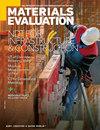Optimizing Probe Active Aperture for Phased Array Weld Inspections
IF 0.3
4区 材料科学
Q4 MATERIALS SCIENCE, CHARACTERIZATION & TESTING
引用次数: 0
Abstract
Phased array ultrasonic testing (PAUT) has become a popular nondestructive technique for weld inspections in piping, pressure vessels, and other components such as turbines. This technique can be used both in manual and automated modes. PAUT is more attractive than conventional angle-beam ultrasonic testing (UT), as it sweeps the beam through a range of angles and presents a cross-sectional image of the area of interest. Other displays are also available depending on the software. Unlike traditional A-scan instruments, which require the reconstruction of B- and C-scan images from raster scanning, a phased array image is much simpler to produce from line scans and easier to interpret. Engineering codes have incorporated phased array technology and provide steps for standardization, scanning, and alternate acceptance criteria based on fracture mechanics. The basis of fracture mechanics is accurate defect sizing. There is, however, no guidance in codes and standards on the selection and setup of phased array probes for accurate sizing. Just like conventional probes, phased array probes have a beam spread that depends on the probe’s active aperture and frequency. Smaller phased array probes, when used for thicker sections, result in poor focusing, large beam spread, and poor discontinuity definition. This means low resolution and oversizing. Accurate sizing for fracture mechanics acceptance criteria requires probes with high resolution. In this paper, guidance is provided for the selection of phased array probes and setup parameters to improve resolution, definition, and sizing of discontinuities.用于相控阵焊接检测的探头有源孔径优化
相控阵超声检测(PAUT)已成为管道、压力容器和其他部件(如涡轮机)焊缝检测的一种流行的无损技术。这种技术可以在手动和自动模式下使用。PAUT比传统的角光束超声检测(UT)更有吸引力,因为它可以将光束扫过一系列角度,并呈现感兴趣区域的横截面图像。其他显示也可根据软件。传统的a扫描仪器需要从光栅扫描中重建B和c扫描图像,与之不同的是,相控阵图像更容易从线扫描中产生,也更容易解释。工程规范已经纳入了相控阵技术,并提供了标准化、扫描和基于断裂力学的替代验收标准的步骤。断裂力学的基础是精确的缺陷尺寸。然而,在规范和标准中没有关于选择和设置相控阵探头以实现精确尺寸的指导。就像传统探头一样,相控阵探头的波束传播取决于探头的有效孔径和频率。较小的相控阵探头,当用于较厚的截面时,会导致聚焦不良,光束扩散大,不连续定义差。这意味着低分辨率和超大尺寸。断裂力学验收标准的精确尺寸要求具有高分辨率的探头。本文为相控阵探头的选择和设置参数提供了指导,以提高不连续点的分辨率、清晰度和尺寸。
本文章由计算机程序翻译,如有差异,请以英文原文为准。
求助全文
约1分钟内获得全文
求助全文
来源期刊

Materials Evaluation
工程技术-材料科学:表征与测试
CiteScore
0.90
自引率
16.70%
发文量
35
审稿时长
6-12 weeks
期刊介绍:
Materials Evaluation publishes articles, news and features intended to increase the NDT practitioner’s knowledge of the science and technology involved in the field, bringing informative articles to the NDT public while highlighting the ongoing efforts of ASNT to fulfill its mission. M.E. is a peer-reviewed journal, relying on technicians and researchers to help grow and educate its members by providing relevant, cutting-edge and exclusive content containing technical details and discussions. The only periodical of its kind, M.E. is circulated to members and nonmember paid subscribers. The magazine is truly international in scope, with readers in over 90 nations. The journal’s history and archive reaches back to the earliest formative days of the Society.
 求助内容:
求助内容: 应助结果提醒方式:
应助结果提醒方式:


